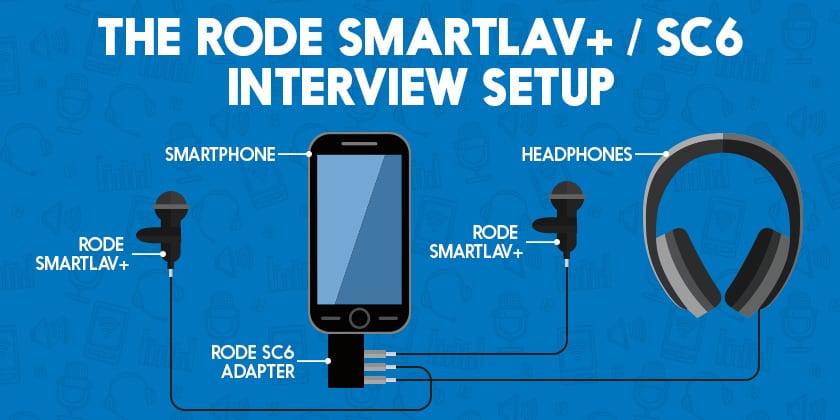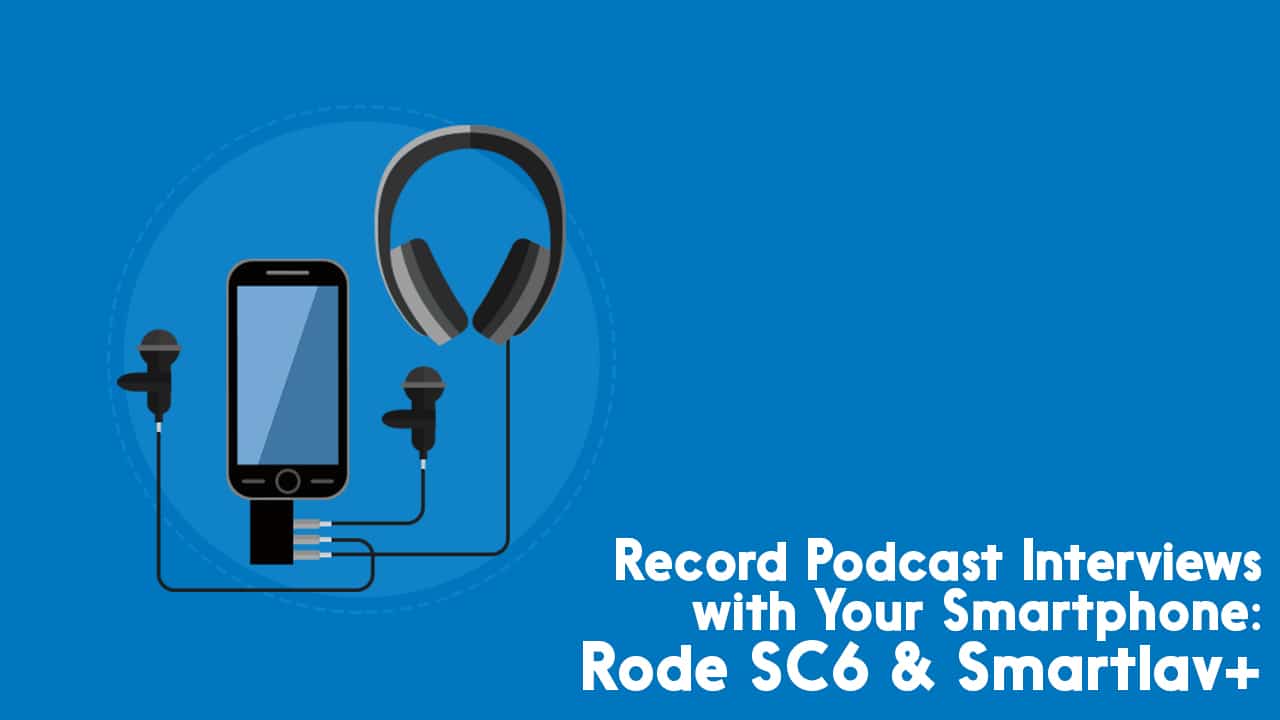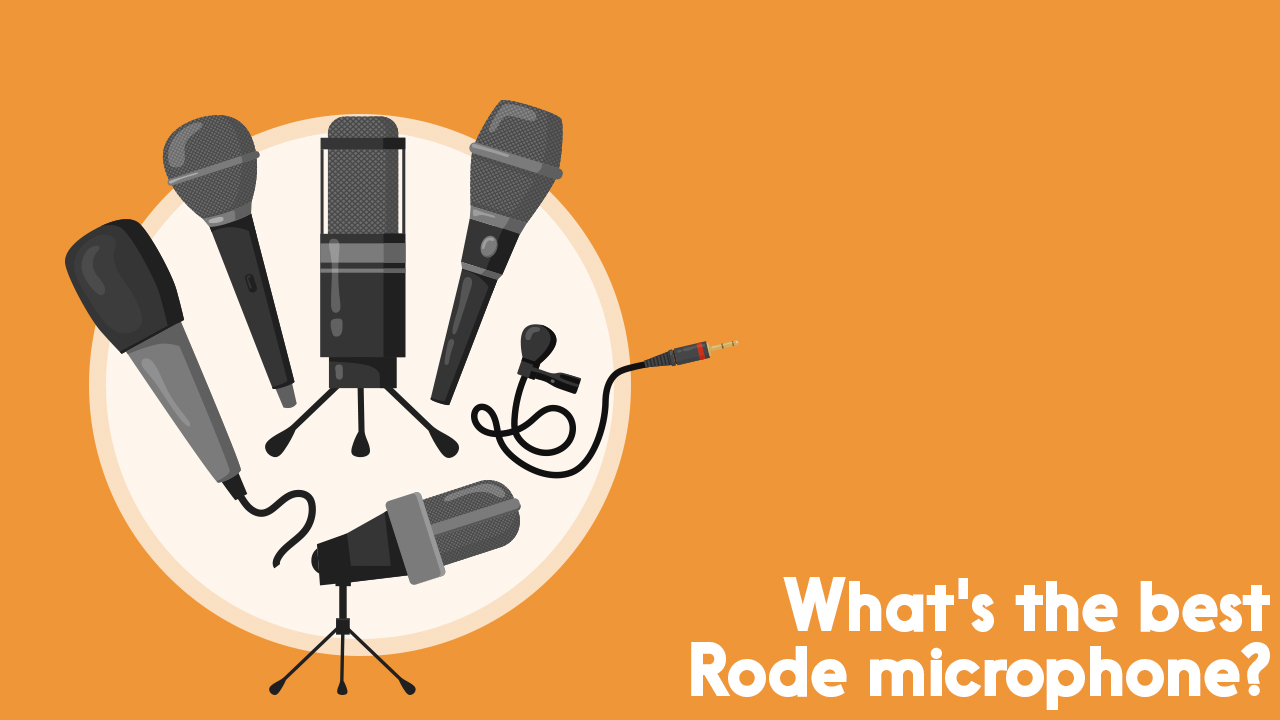Why record podcast interviews with a smartphone? Because sometimes, you just need it easy. Flexibility is great, sure; options, quality, power, all have their place. But, when you just need to get a podcast recorded, and time’s a’wastin’, easy is the way.
Now, what happens when easy miraculously coincides with quality and flexibility? Awesome sauce. Right here I want to talk about just that: a super-simple, high-quality, equipment setup for recording podcast interviews with a smartphone. TheRode Smartlav+ lavalier microphone and the SC6 adapter. (newer iPhone users, see the SC6-L adapter)
Want the short story? Skip to the equipment setup. Want the long story: the how and the why? Read on!
It’s also worth mentioning that we’re focusing on local, in-person podcast interviews in this article. If you’re looking to record interviews remotely, then check out our best tools for recording conversations online. You might also want to check out our full guide to podcast interviews.
But if you’re here for the in-person stuff, let’s crack on…
What is the Rode Smartlav+?
Despite the fact that we talk about a lot of ways to do a podcast, interview recording setups are still the most common reader question. The Rode Smartlav+ is my stock answer for most of them.
The Smarlav+ is a lavalier microphone, which means it’s a tiny little device designed to clip to your shirt. Think back to the last in-studio TV interview you saw. Did you spot that little black dot stuck to their chest? That’s a lavalier microphone.
Lavs are designed to be subtle for that exact purpose. To allow one or more people to speak without the visual or the physical bother of a microphone. But, they come with other advantages too.
Why Are Lavalier Microphones Great for Interviews?
1. You Don’t Have to Worry About Mic Technique
The usual alternative for interviews is a hand-held mic, like the Shure SM58 or the Samson Q2U. The problem with them is that your interviewee probably hasn’t held a mic before. If they have, then it’s likely without any training. Sadly, without training, it’s easy to mess up a recording beyond all help.
Handheld mics should be held a particular distance from the mouth, and in a particular position. They should also be handled really carefully to avoid nasty handling noises. Here’s our full guide to podcast mic technique, if you’d like a deeper dive on that front.
But you can’t expect an inexperienced interviewee to get all of this right. Sometimes they’ll be too far away, or too close at others, popping the mic like a crazed peter piper picking a peck of pickled peppers.
Lav mics get rid of all of that. It’s pinned in one place and, from there, technique no longer matters.
2. Your Guests Can Relax
Ever had a really irritating, talkative co-worker who just won’t shut up? Here’s a tip: stick a big mic in front of them. In my experience, that’s an iron-clad way to get someone to shut their face-hole.
It’s true, though. If your interviewee isn’t used to it, a microphone is intimidating. It puts the pressure on, reminding them every second that they’re being recorded.
I’ve seen friendly, charismatic people transform into nervous little flowers thanks to that pressure. It’s weird how formal people become, spouting jargon and big words as if they’re trying to impress someone. And they are. The mic!
A lavalier mic gets around this. You pin it on, and within minutes, the speaker’s forgotten it’s there. It means you end up having a conversation, rather than an interview. It’s more natural, more honest and much more compelling.
Even with experienced co-hosts, a pair of lav mics can make for far better material. Again, it’s the act of removing the tech – turning a recording into a conversation.
Why Is the Rode Smartlav+ Great for Recording Podcast Interviews With a Smartphone?
There are a bunch of lavalier mics on the market, as you can see in our lavalier roundup. So, why the Smartlav?
1. You Don’t Need a Recorder – Just a Smartphone
This is the main one: you can record with a device you’re already carrying. No need to carry a separate recorder, worrying about batteries or transferring files.
Just plug the Smarlav, or the SC6, into the headphone jack on your phone, and then hit record on your voice recorder app. Every smartphone has one.
If you want to get fancy, you can even upgrade your recording app. There’s plenty out there, some with mixing or editing functions too.
2. You Can Record Two People With a Simpler Adapter
The SC6 adapter (newer iPhone users, see the SC6-L adapter) is the master-stroke here from Rode. It’s nothing more than a splitter, really, that lets you plug two Smartlavs into one smartphone. That means you can record two people with great quality, perfectly synced into one device. So simple, but so powerful!
Yep, splitters have existed for years, but the quality can be variable and it’s up to the user to figure out what they need. These are made specifically for the Smartlav, and they just work.
3. It’s So Small and Portable
This setup is so portable that I take it everywhere I go. I have two Smartlavs and an SC6 adapter coiled up into one of the little Smartlav drawstring bags. It fits in your palm and weighs less than a slice of bread.
My set is always in my bag, so if I got to an event or a meeting it’s there and ready for an interview on the fly.
What Else Can the Rode Smartlav+ Do?
This article is all about the 2-person recording setup, but that’s not all I use my Smartlavs for.
1. Record on the Move
A friend of mine, Andy Brown from Triple Your Clients, used to record his podcast with a Smartlav while he was out walking his dog. It was brilliant! The forest sounds and the birds tweeting gave it so much atmosphere. He always sounded full of energy, too, because he was up and active.
This isn’t limited to the Smartlav, of course. You could record, on the go, with any lav mic and a little recorder. The problem is, I wouldn’t carry a digital recorder around all the time, even a small one. I’ve always got my Smartlav and a smartphone with me, though, so recording’s a cinch.
2. Record More Often
This is related to the point above. The fact that you can record on-the-go gives you loads more options when it comes to fitting your podcast in.
We all know what it feels like to have our creative time squeezed. When the crazy time hits, podcasting, blogging, video are the first to go.
But, if you could record a podcast while you’re out for a walk, or stuck in traffic, or waiting for a bus, how much more likely are you to do it, every single week?
The Full Setup: Rode Smartlav+ and SC6 to Record Podcast Interviews with a Smartphone

You can probably tell, I’m a bit of a fan of the Smartlav. Even better, paired with the SC6 adapter it offers an interview setup that anyone can use, and can be carried in your pocket.
Here’s our recommended full kit for recording podcast interviews with a smartphone. A quick heads up that we use affiliate links here, which help support all the free content we put out. Should you choose to buy through them, we may earn a small commission, though at no extra cost to yourself.
- 2 x Rode Smartlav+ lavalier microphones
- 1 x SC6 adapter (newer iPhone users, see the SC6-L adapter)
- Optional: Headphones – any kind – here’s what I use.
The Rode Smartlavs plug into the SC6 and it, in turn, plugs into your Smartphone. There’s also a headphone port on the SC6 to allow you to listen back to recordings. Hence the ‘optional’ headphones listed above.
This setup will turn any smartphone into a great quality two-way interview setup. Equally, it allows anyone to record a co-hosted show and offers up a bunch of flexibility in where and when you do it.
Need More Help Choosing Podcast Equipment?
If you need some more tailored advice for your own setup, or want help with any other aspect of podcasting, then take a look at Podcraft Academy.
In there, you’ll find access to all of our video courses, tutorials, ebooks, and downloadable resources.
On top of that, we run weekly live Q&A sessions where you can get all your questions answered on an ongoing basis. Having the ability to get feedback, advice, and guidance on-tap can go a long way towards keeping you podcasting. That’s what we’re here for!

